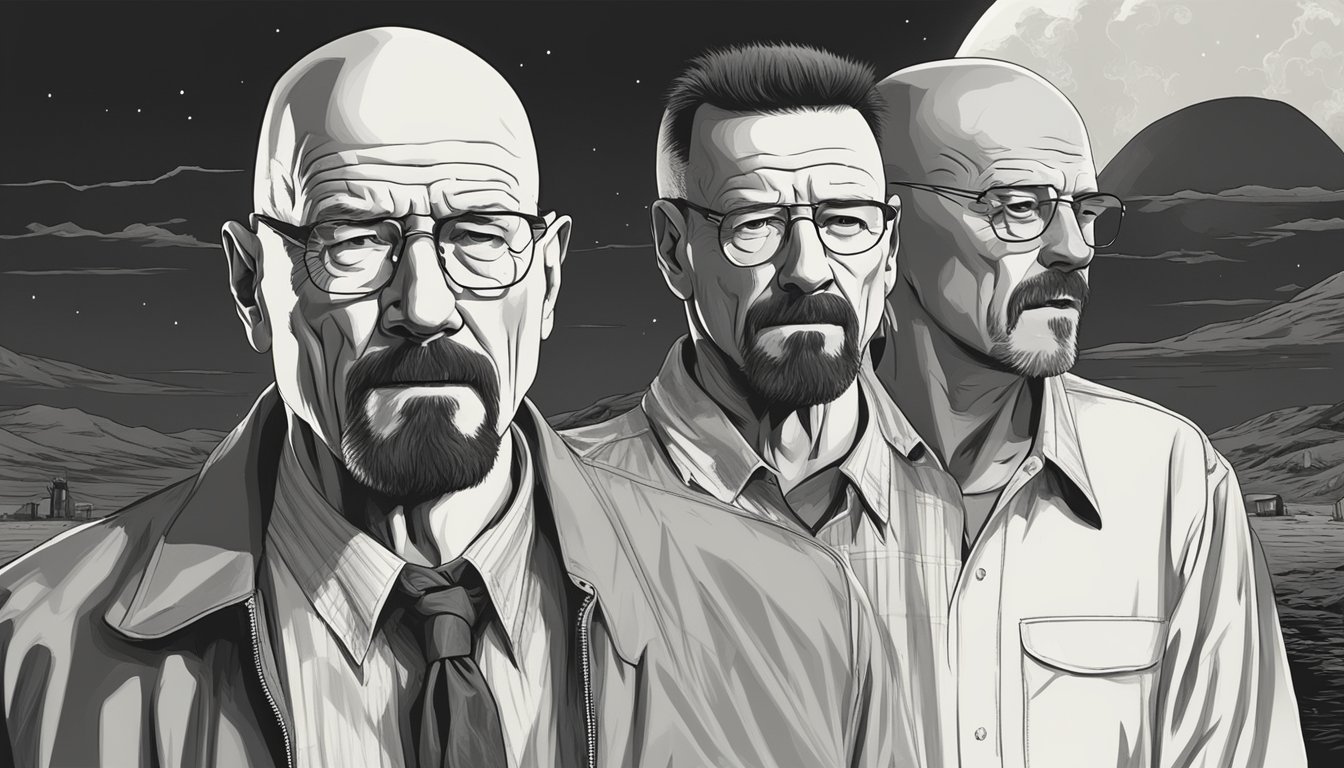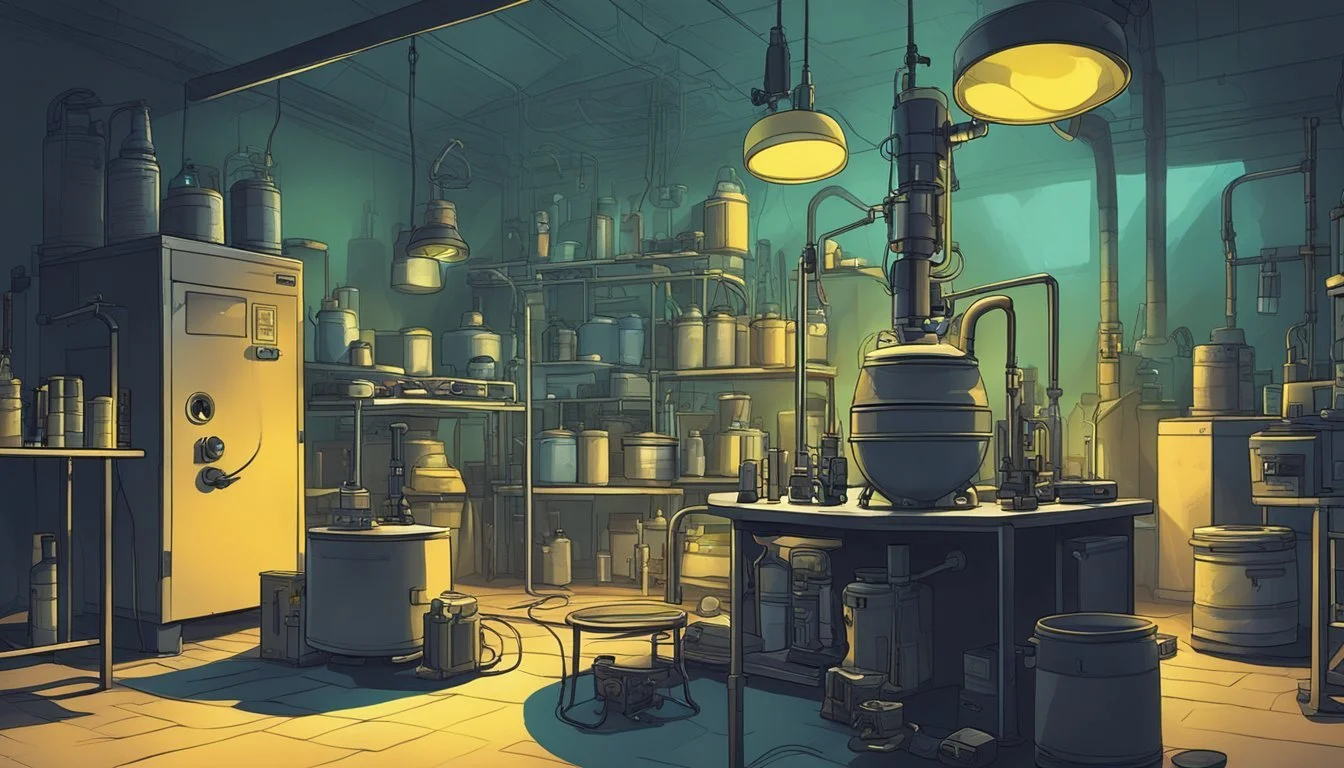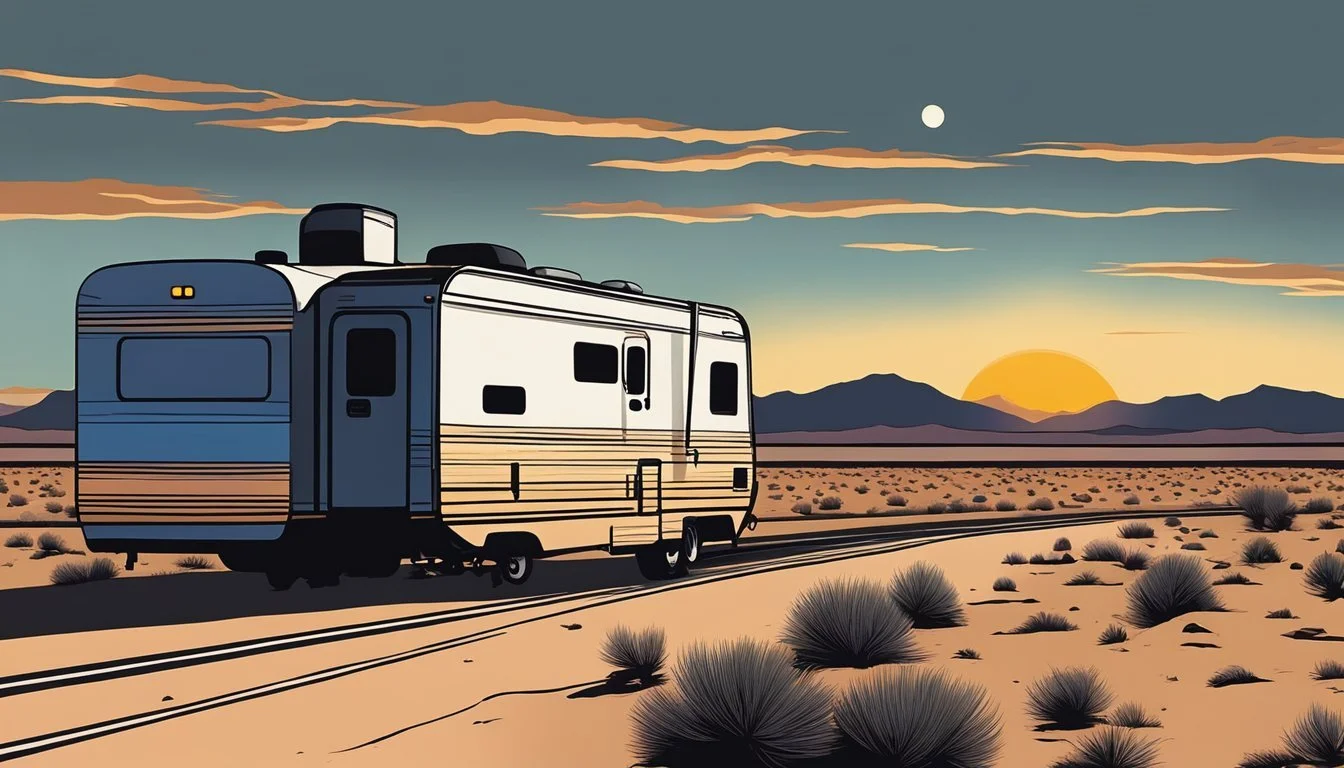Breaking Bad's Use of Music
Sonic Journey Through Walter White's Downfall
Breaking Bad's iconic status in television history owes much to its masterful use of music. The show's soundtrack, combining an original score by Dave Porter with carefully selected licensed tracks, played a crucial role in amplifying the narrative's descent into darkness. Porter's haunting melodies and atmospheric soundscapes became an integral part of the series' identity, heightening tension and emotion throughout Walter White's transformation from mild-mannered chemistry teacher to ruthless drug kingpin.
The composers and music supervisors employed a diverse range of sounds to underscore Breaking Bad's complex themes. From twangy guitars to percussive rhythms, the music often eschewed traditional scoring techniques in favor of more experimental approaches. This unconventional style perfectly complemented the show's unexpected plot twists and morally ambiguous characters.
Licensed songs also featured prominently in Breaking Bad, with tracks carefully chosen to enhance pivotal scenes. These musical selections ranged from obscure indie artists to well-known classics, each serving to deepen the emotional impact of key moments in the series. The result was a rich sonic tapestry that elevated Breaking Bad's storytelling to new heights, cementing its place as one of television's most aurally compelling dramas.
Musical Identity of Breaking Bad
Breaking Bad's distinctive musical landscape profoundly shaped the series' atmosphere and character development. The show's sonic elements blended original compositions with carefully selected tracks to create a unique auditory experience.
The Role of Dave Porter and the Original Score
Dave Porter's original score formed the backbone of Breaking Bad's musical identity. His compositions expertly captured the show's tonal shifts, from tense suspense to emotional depth. Porter utilized a mix of electronic and organic sounds to reflect the series' themes of transformation and moral decay.
The score evolved alongside Walter White's character arc, incorporating darker and more complex elements as the story progressed. Porter's work seamlessly integrated with the visual storytelling, enhancing pivotal moments and underscoring character motivations.
Significance of the Title Theme
The Breaking Bad title theme, composed by Dave Porter, became an instantly recognizable auditory signature for the series. Its brief yet impactful 18-second duration encapsulated the show's essence.
The theme's distorted twang and percussive elements evoked a sense of unease and danger. It served as a sonic representation of Walter White's transformation into Heisenberg. The theme's industrial sounds mirrored the harsh, chemical world of meth production central to the plot.
Integration of Soundtracks and Episode Themes
Breaking Bad's use of licensed music complemented Porter's score, creating a rich tapestry of sound. The show's creators meticulously selected tracks to enhance narrative themes and emotional resonance.
Songs often reflected characters' states of mind or foreshadowed plot developments. Notable examples include:
"Crystal Blue Persuasion" by Tommy James and the Shondells during a meth-cooking montage
"Baby Blue" by Badfinger in the series finale, tying into Walter White's product and legacy
This careful integration of soundtrack choices with episode themes heightened the viewing experience, making music an essential storytelling tool in Breaking Bad's arsenal.
Character Themes and Musical Evolution
Breaking Bad's music evolved alongside its characters, creating distinct sonic identities that reflected their development and emotional states. The score intricately wove themes for key players, enhancing their arcs and relationships throughout the series.
Walter White and the Path of Heisenberg
Walter White's transformation from mild-mannered chemistry teacher to ruthless drug kingpin was mirrored in his musical theme. Initially, his motif featured subdued, melancholic tones reflecting his ordinary life. As Heisenberg emerged, the theme incorporated darker, more aggressive elements.
Percussive rhythms and distorted synths grew more prominent, signaling Walter's descent into criminality. The theme's evolution paralleled his increasing confidence and moral decay.
By the final season, Walter's theme had become a menacing, industrial soundscape. It conveyed the full realization of Heisenberg's power and the complete corruption of Walter White's former self.
Jesse Pinkman's Emotional Journey
Jesse Pinkman's musical theme reflected his tumultuous emotional state and struggle for identity. His early appearances were often accompanied by energetic, chaotic sounds mirroring his impulsive nature.
As Jesse faced trauma and loss, his theme incorporated more somber, introspective elements. Acoustic guitar and piano melodies highlighted his vulnerability and desire for redemption.
In later seasons, Jesse's theme blended elements of his past with newfound maturity. It retained hints of chaos but introduced more complex harmonies, illustrating his growth and inner conflict.
Other Key Characters and Their Sonic Footprints
Gus Fring's theme exuded calm menace, using subtle Latin American influences and ominous drones to convey his calculated ruthlessness. As his facade cracked, dissonant elements crept in.
The Cousins were characterized by a primal, percussive motif. Their theme used minimal melody, relying on rhythmic intensity to convey their single-minded brutality.
Skyler White's musical identity evolved from light, domestic tones to more complex arrangements as she became entangled in Walter's criminal world. Her theme incorporated elements of tension and unease, reflecting her conflicted loyalties.
Instrumentation and Production Techniques
Breaking Bad's innovative soundtrack blended electronic and acoustic elements to create a unique sonic landscape. Composer Dave Porter utilized a mix of vintage synthesizers, world instruments, and orchestral sounds to enhance the show's narrative and emotional impact.
Use of Synthesizers and Electronic Instruments
Dave Porter relied heavily on synthesizers to craft Breaking Bad's distinctive sound. He favored vintage instruments like the ARP 2600, Oberheim Matrix-12, and Voyetra-8 for their rich, analog tones. These synths provided the foundation for many of the show's atmospheric cues and tension-building moments.
In one memorable scene from season four, Porter used an ARP 2600 to create a pulsing "heartbeat" effect. This sound underscored Walter White's panic as he searched for his missing money stash in the crawl space beneath his house.
Electronic instruments allowed Porter to produce otherworldly textures and evolving soundscapes. These sonic elements mirrored the characters' descent into moral ambiguity and the increasingly unstable world of the show.
Incorporating World and Western Orchestral Instruments
To add depth and cultural context to Breaking Bad's score, Porter incorporated a variety of world instruments. Andean flutes evoked the southwestern setting, while resonator guitars brought a touch of Americana to certain cues.
Japanese kotos and other exotic stringed instruments created an air of mystery and unease in key scenes. These unconventional choices helped set Breaking Bad's music apart from typical television scores.
Western orchestral instruments also played a crucial role. String sections added emotional weight to pivotal moments, while brass and woodwinds contributed to the score's more traditional dramatic cues.
This blend of world and orchestral sounds gave Porter a vast palette to work with. He could seamlessly transition between intimate character moments and grand, sweeping themes as the story demanded.
The Role of Music Supervision
Music supervisor Thomas Golubic played a vital part in shaping Breaking Bad's sonic identity. He worked closely with the show's creators to select pre-existing songs that complemented Porter's original score.
Golubic's choices often provided ironic counterpoint to on-screen events or deepened character development. His selections ranged from obscure international tracks to recognizable pop hits, each carefully chosen to enhance the storytelling.
One notable example was the use of the Spanish-language song "Negro y Azul" in season two. This narcocorrido ballad referenced Walter White's alter ego, Heisenberg, further blurring the lines between fiction and reality within the show's universe.
Golubic's expertise ensured that Breaking Bad's licensed music felt organic to the series. His selections worked in harmony with Porter's score to create a cohesive audio landscape.
Iconic Moments and Their Musical Counterparts
Breaking Bad's masterful use of music elevated key scenes to unforgettable status. The show's soundtrack choices amplified emotional impact and deepened thematic resonance across pivotal moments.
The Transformation Scene in 'Crawl Space'
Walter White's descent into madness in "Crawl Space" is accentuated by a haunting musical score. As he frantically searches for missing money, the background music intensifies, mirroring his mental unraveling.
The scene's soundtrack features a mix of discordant tones and a pulsing heartbeat-like rhythm. This audio landscape heightens the claustrophobic atmosphere and Walt's growing panic.
Dave Porter's original composition for this sequence blends industrial sounds with unsettling strings. The music crescendos as Walt's hysterical laughter echoes through the crawl space, marking a crucial turning point in his character arc.
Soundtrack Choices in 'Phoenix' and 'Felina'
"Phoenix" and "Felina" showcase Breaking Bad's knack for impactful musical selections. In "Phoenix," the somber tune "Enchanted" by The Platters plays as Jane overdoses, creating a stark contrast between the romantic lyrics and the tragic scene.
"Felina," the series finale, features Badfinger's "Baby Blue" in its closing moments. The song's opening lyrics, "Guess I got what I deserved," serve as a fitting epitaph for Walter White's journey.
Another notable track in "Felina" is "El Paso" by Marty Robbins, which foreshadows Walt's fate and ties into the episode's themes of love, betrayal, and death.
'Negro Y Azul' and the Narco-Corrido
The narco-corrido "Negro Y Azul" by Los Cuates de Sinaloa plays a unique role in Breaking Bad's musical landscape. This custom-written song serves as both diegetic and non-diegetic music in the show.
"Negro Y Azul" tells the story of Heisenberg's growing notoriety in the drug world. Its upbeat melody contrasts with its violent lyrics, reflecting the show's dark humor.
The song's inclusion demonstrates Breaking Bad's attention to cultural authenticity. It showcases how Walter White's actions have far-reaching consequences, even inspiring a narco-ballad about his exploits.
Recurring Musical Themes and Continuity
Breaking Bad's score features several recurring musical motifs that underscore character development and thematic progression throughout the series. These carefully crafted themes provide sonic continuity and deepen the audience's emotional connection to the story.
Symbolism Through Recurrence
Dave Porter's original score for Breaking Bad employs recurring musical elements to symbolize key aspects of the show. The distinctive twang in the main title theme reappears in various forms, often signaling pivotal moments in Walter White's transformation. Certain melodic phrases are associated with specific characters or situations, creating a musical shorthand for viewers.
The use of Southwestern desert rock influences in recurring tracks reinforces the New Mexico setting. This musical choice grounds the series in its geographical context while contributing to its unique audio identity.
'The Long Walk Alone' and Character Progression
'The Long Walk Alone' serves as a significant recurring theme in Breaking Bad, evolving alongside Walter White's character arc. Initially, the track conveys a sense of isolation and moral struggle. As the series progresses, its arrangement becomes more complex and intense, mirroring Walt's descent into the criminal underworld.
This theme often plays during pivotal decision-making moments, underscoring the consequences of Walt's choices. Its use in end credits sequences provides a musical bookend to episodes, inviting reflection on character development. The gradual transformation of 'The Long Walk Alone' parallels Walt's journey, making it a powerful tool for conveying his internal conflicts without dialogue.
Music in Spin-Offs and Continuations
The musical legacy of Breaking Bad extended into its spin-offs and continuations, maintaining thematic connections while establishing unique identities. Composer Dave Porter played a crucial role in shaping the sonic landscape across the expanded Breaking Bad universe.
'Better Call Saul' and Its Own Identity
Better Call Saul's music, while connected to Breaking Bad, carved out its own distinct sound. Dave Porter, who scored both series, approached Better Call Saul with a fresh perspective. The spin-off's music reflected Jimmy McGill's gradual transformation into Saul Goodman, using subtle musical cues to highlight character development.
Porter incorporated elements from Breaking Bad's score but adapted them to fit Better Call Saul's tone. He employed a mix of original compositions and carefully selected licensed tracks to enhance the show's narrative and emotional impact.
Continuing the Legacy in 'El Camino'
El Camino: A Breaking Bad Movie maintained musical continuity with the original series while introducing new elements. Dave Porter returned to compose the score, ensuring a familiar sonic backdrop for Jesse Pinkman's post-Breaking Bad journey.
The film's music built upon established themes from the series, evoking nostalgia while supporting the new narrative. Porter blended atmospheric sounds with more traditional instrumentation, mirroring Jesse's struggle to reconcile his past with his uncertain future.
Licensed tracks in El Camino were chosen to complement the score and reinforce the film's themes of escape and redemption.
Music and Setting: Crafting the New Mexico Atmosphere
Breaking Bad's soundtrack expertly blends with its New Mexico setting, creating a unique audio-visual experience. The music captures the essence of Albuquerque's urban landscape and the surrounding desert, enhancing the show's atmosphere.
Capturing the Essence of the Desert Landscape
The show's composers utilized distinctive sounds to evoke the vastness of the New Mexico desert. Twangy guitar riffs and sparse percussion mimic the arid, open spaces.
Ambient drones and eerie synth textures create a sense of isolation, reflecting the characters' moral emptiness. These sonic elements mirror the harsh beauty of the desert terrain.
The main title theme incorporates elements of Southwestern desert rock. Its 17-second composition features a resonator guitar, instantly transporting viewers to the show's setting.
Musical Depictions of Albuquerque's Urban Canvas
In contrast to the desert themes, urban Albuquerque scenes often feature grittier, more intense musical cues. Hip-hop beats and electronic elements represent the city's diverse cultural landscape.
The composers use subtle musical shifts to differentiate between suburban and inner-city locations. Quieter, more melodic passages accompany residential scenes, while harsher tones underscore dangerous urban encounters.
Local musical influences, such as Latin rhythms and Southwestern folk elements, are woven into the soundtrack. This approach grounds the show in its specific geographical and cultural context.
Behind the Scenes: The Creation of Breaking Bad's Score
Dave Porter's innovative musical approach became a defining element of Breaking Bad's atmosphere. His collaborations with the show's creators and input from the cast shaped the sonic landscape that accompanied Walter White's descent into darkness.
Dave Porter's Creative Process
Porter crafted Breaking Bad's score through experimentation and intuition. He blended electronic and acoustic elements to create a unique sound palette that evolved with the characters.
The composer often started with unconventional instruments or sounds, manipulating them to produce eerie textures and dissonant harmonies. This approach mirrored the show's transformation of everyday objects into tools of the drug trade.
Porter's process involved close analysis of each episode's script and rough cut. He aimed to enhance the emotional undercurrents of scenes without overpowering the dialogue or action.
Collaboration with Vince Gilligan and the Writers
Vince Gilligan, Breaking Bad's creator, worked closely with Porter to shape the show's musical identity. Their partnership began early in the production process, with Gilligan sharing scripts and discussing thematic elements.
The writing team provided Porter with insights into character arcs and plot developments. This allowed him to create musical themes that foreshadowed events or reflected character growth.
Gilligan and Porter held regular spotting sessions to determine music placement. They focused on using score sparingly, often opting for silence to heighten tension in key moments.
Reflections from Cast and Crew
Breaking Bad's cast members frequently praised Porter's contributions in interviews and podcasts. Bryan Cranston noted how the score enhanced his performance, helping him tap into Walter White's emotional state.
Aaron Paul described the music as another character in the show, citing its ability to create suspense and unease. The actor mentioned feeling the impact of Porter's compositions even during filming.
Crew members highlighted the score's role in post-production. Editors spoke about how Porter's music elevated scenes, often transforming good moments into unforgettable ones.
Cultural Impact and Reception
Breaking Bad's innovative use of music left an indelible mark on television and popular culture. The show's soundtrack garnered widespread acclaim, resonated deeply with fans, and influenced future TV productions.
Critical Acclaim and Awards
Breaking Bad's musical score received numerous accolades during its run. Composer Dave Porter's work earned Emmy nominations for Outstanding Original Main Title Theme Music and Outstanding Music Composition for a Series. The show's music supervision team also garnered recognition, winning Guild of Music Supervisors Awards for their expert song selections.
Critics praised the soundtrack's ability to enhance the storytelling and emotional impact of key scenes. The carefully chosen tracks and original compositions became integral to the series' identity, elevating tension and underscoring character development.
Fan Favorites: Popular Tracks and Moments
Several musical moments from Breaking Bad became iconic among fans. The use of "Crystal Blue Persuasion" by Tommy James and the Shondells during a meth-cooking montage garnered particular attention for its clever lyrical relevance.
Other standout tracks included:
"Baby Blue" by Badfinger in the series finale
"Negro y Azul: The Ballad of Heisenberg"
TV on the Radio's "DLZ" during Walt's parking lot confrontation
These songs often saw spikes in popularity and downloads following their appearance on the show, demonstrating the series' cultural influence.
Breaking Bad's Musical Legacy in Television
Breaking Bad's approach to music set a new standard for television soundtracks. Its blend of original score and carefully selected songs inspired other AMC series and TV productions across networks.
The show's success encouraged more daring and unconventional musical choices in television. It demonstrated how a well-crafted soundtrack could become a character in itself, driving narrative and deepening audience engagement.
Breaking Bad's musical legacy continues to influence modern TV storytelling, with many series now placing greater emphasis on creating cohesive and impactful audio landscapes to complement their visual narratives.





